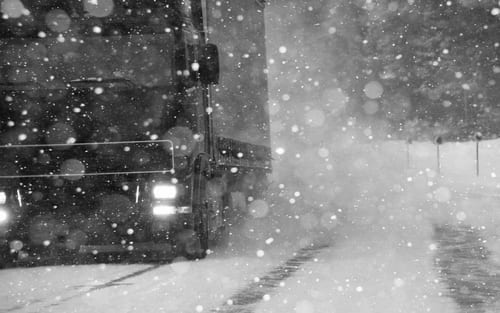Well, everyone, it’s here: The inevitable transition to winter weather and winter driving conditions in North Dakota. At this point in our lives, most of us are accustomed to driving our typical passenger vehicles in inclement weather, remembering to operate at a slower speed, and keeping a longer following distance as a general rule of thumb. These tips have probably been ingrained in us since we began driving and have been put to use with our experiences on the roadway. However, driving in these same inclement conditions while operating a commercial motor vehicle (CMV; like a semi) is a completely different story, meaning there are different tips CMV drivers must follow. Due to their heavyweight (anywhere from 20,000 to 80,000 pounds) and overall size and frame, CMV’s must abide by different rules and regulations than regular passenger cars to ensure the safety of others on the road, as well as their own.
Here are some tips for those that will be on the road operating a CMV in winter conditions:
Slow Down
The first and arguably most important tip for driving in inclement weather is to slow down. The North Dakota CDL manual recognizes three different types of surfaces or conditions in Section 2.6.2 and provides guidelines as to what CMV drivers should do if confronted with them.
- Wet Road Conditions: Semi drivers are to slow their speed by one-third (i.e., if you are traveling at 55mph, the CDL manual suggests slowing down to 35).
- Packed Snow: Semi drivers are to slow down by one-half of their speed (i.e., if you are traveling at 60 mph, the CDL manual suggests slowing down to 30).
- Ice: Semi drivers are to reduce their speed to a crawl, and stop driving as soon as they can do so safely.
If you remember any of the following tips, remember this one – please, please slow down during winter weather conditions.
Maintain A Safe Distance From The Vehicle In Front Of You
Since semis are heavier and larger, it’s reasonable to assume that they take longer to stop than typical passenger vehicles. Maintaining a safe following distance can be the deciding factor in whether or not a crash occurs, so be sure to follow safely. The Federal Motor Carrier Safety Administration (FMCSA) recommends that semi-drivers keep a following distance of one second for every 10 feet of vehicle length, however, this recommendation doubles when there is inclement weather. If a passenger vehicle is to spin out or lose control ahead of the semi, the CMV driver must recognize and respond to this by slowing down and maintaining a safe distance.
Use Proper Lights & Turn Signals
In winter weather conditions, please turn on your headlights. It’s important that other drivers on the road see you, especially in foggy and snow falling conditions. If you need to change lanes or merge off the road, make sure to use your turn signals, i.e., blinkers. As a general rule, wait three “blinks” of your blinkers before moving over in dry or rainy weather. Wait four or five “blinks”, then move over slowly when the weather is more inclement and visibility is more difficult. Inadequate surveillance can often be the cause of a crash, so make sure you’re checking your mirrors often and looking far enough ahead before turning on your blinkers to begin changing lanes.
If you’re operating at a significantly slower speed than others around you, make sure to put on your hazard lights so others can see you and know it’s okay to pass if necessary.
Avoid “Boxing-In” Other Vehicles
Although sometimes hard to avoid on multiple-lane highways and interstates, CMV drivers should do their best to refrain from boxing in or “sandwiching” a passenger vehicle between themselves and another semi. The passenger vehicle is subject to many vulnerabilities in this position and gives them little to no opportunity to react in the event of an unexpected merge or if either CMV hits high winds or ice.
Keep An Eye On The Wind
Windy conditions are sometimes challenging for CMV drivers even without inclement weather. It seems that more often than not, a high wind speed accompanies snow and makes visibility difficult, especially in rural areas or stretches of interstate that are wide open. CMV’s also have a significantly different weight distribution than smaller vehicles, so it’s easy for windy conditions to push them into a different lane or off the road completely. Make sure you’re aware of the wind speed at all times, with and without a loaded trailer.
Use Exit Ramps And Get Off The Road If/When Necessary
If the weather reaches a point where you are uncomfortable operating your truck or semi, or you encounter ice, slow your vehicle down and look for the nearest exit ramp or rest area. It’s far more important to wait out weather conditions than it is to continue on and risk your life and the lives of others.
Conclusion
While driving in inclement weather can be dangerous for all drivers, this is especially true for drivers operating semis or commercial motor vehicles. The special rules and regulations that exist for semi drivers are to ensure the safety of everyone on the road. Please follow them during the coming winter months.
This area of law is highly technical and it is important you have an attorney who understands the huge difference between a regular car crash and one involving a commercial motor vehicle. If you or a loved one has been catastrophically injured or killed in a crash involving a commercial motor vehicle, it is very important you hire an attorney who knows trucking laws and regulations. Our personal injury team at SW&L Attorneys understands, knows, and handles all trucking and commercial motor vehicle accidents. To get in touch with our team, call 701-297-2890, or email info@swlattorneys.com.










